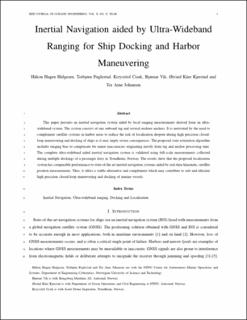| dc.contributor.author | Helgesen, Håkon Hagen | |
| dc.contributor.author | Fuglestad, t | |
| dc.contributor.author | Cisek, Krzysztof Piotr | |
| dc.contributor.author | Vik, Bjørnar | |
| dc.contributor.author | Kjerstad, Øivind Kåre | |
| dc.contributor.author | Johansen, Tor Arne | |
| dc.date.accessioned | 2023-01-03T08:10:23Z | |
| dc.date.available | 2023-01-03T08:10:23Z | |
| dc.date.created | 2022-12-21T22:52:20Z | |
| dc.date.issued | 2022 | |
| dc.identifier.issn | 0364-9059 | |
| dc.identifier.uri | https://hdl.handle.net/11250/3040445 | |
| dc.description.abstract | This article presents an inertial navigation system aided by local ranging measurements derived from an ultra-wideband system. The system consists of one onboard tag and several onshore anchors. It is motivated by the need to complement satellite systems in harbor areas to reduce the risk of localization dropout during high precision closed-loop maneuvering and docking of ships as it may imply severe consequences. The proposed state estimation algorithm includes ranging bias to compensate for minor inaccuracies originating mostly from tag and anchor processing time. The complete ultra-wideband aided inertial navigation system is validated using full-scale measurements collected during multiple dockings of a passenger ferry in Trondheim, Norway. The results show that the proposed localization system has comparable performance to state-of-the art inertial navigation systems aided by real-time kinematic satellite position measurements. Thus, it offers a viable alternative and complement which may contribute to safe and efficient high precision closed-loop maneuvering and docking of marine vessels. | en_US |
| dc.language.iso | eng | en_US |
| dc.publisher | IEEE | en_US |
| dc.title | Inertial Navigation aided by Ultra-Wideband Ranging for Ship Docking and Harbor Maneuvering | en_US |
| dc.title.alternative | Inertial Navigation aided by Ultra-Wideband Ranging for Ship Docking and Harbor Maneuvering | en_US |
| dc.type | Peer reviewed | en_US |
| dc.type | Journal article | en_US |
| dc.description.version | acceptedVersion | en_US |
| dc.rights.holder | © IEEE. Personal use of this material is permitted. Permission from IEEE must be obtained for all other uses, in any current or future media, including reprinting/republishing this material for advertising or promotional purposes, creating new collective works, for resale or redistribution to servers or lists, or reuse of any copyrighted component of this work in other works. | en_US |
| dc.source.journal | IEEE Journal of Oceanic Engineering | en_US |
| dc.identifier.doi | http://dx.doi.org/10.1109/JOE.2022.3186474 | |
| dc.identifier.cristin | 2096704 | |
| dc.relation.project | Norges forskningsråd: 223254 | en_US |
| cristin.ispublished | true | |
| cristin.fulltext | postprint | |
| cristin.qualitycode | 1 | |
